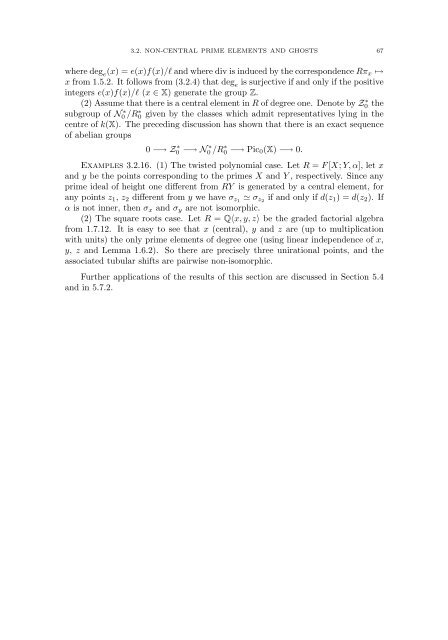MEMOIRS
MEMOIRS
MEMOIRS
- No tags were found...
You also want an ePaper? Increase the reach of your titles
YUMPU automatically turns print PDFs into web optimized ePapers that Google loves.
3.2. NON-CENTRAL PRIME ELEMENTS AND GHOSTS 67where deg e (x) =e(x)f(x)/l and where div is induced by the correspondence Rπ x ↦→x from 1.5.2. It follows from (3.2.4) that deg e is surjective if and only if the positiveintegers e(x)f(x)/l (x ∈ X) generate the group Z.(2) Assume that there is a central element in R of degree one. Denote by Z0 ∗ thesubgroup of N0 ∗ /R0 ∗ given by the classes which admit representatives lying in thecentre of k(X). The preceding discussion has shown that there is an exact sequenceof abelian groups0 −→ Z0 ∗ −→ N0 ∗ /R0 ∗ −→ Pic 0 (X) −→ 0.Examples 3.2.16. (1) The twisted polynomial case. Let R = F [X; Y,α], let xand y be the points corresponding to the primes X and Y , respectively. Since anyprime ideal of height one different from RY is generated by a central element, forany points z 1 , z 2 different from y we have σ z1 ≃ σ z2 if and only if d(z 1 )=d(z 2 ). Ifα is not inner, then σ x and σ y are not isomorphic.(2) The square roots case. Let R = Q〈x, y, z〉 be the graded factorial algebrafrom 1.7.12. It is easy to see that x (central), y and z are (up to multiplicationwith units) the only prime elements of degree one (using linear independence of x,y, z and Lemma 1.6.2). So there are precisely three unirational points, and theassociated tubular shifts are pairwise non-isomorphic.Further applications of the results of this section are discussed in Section 5.4and in 5.7.2.
















